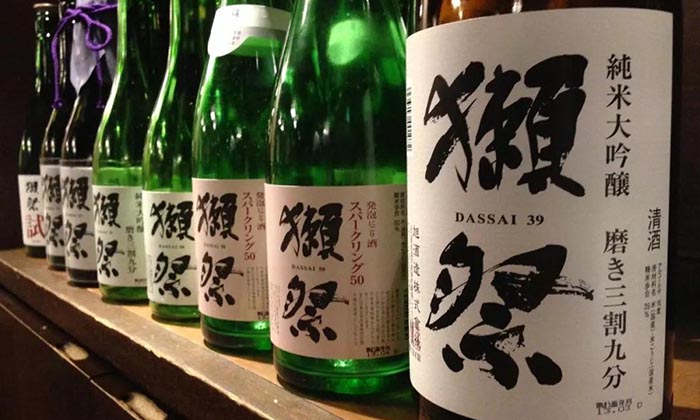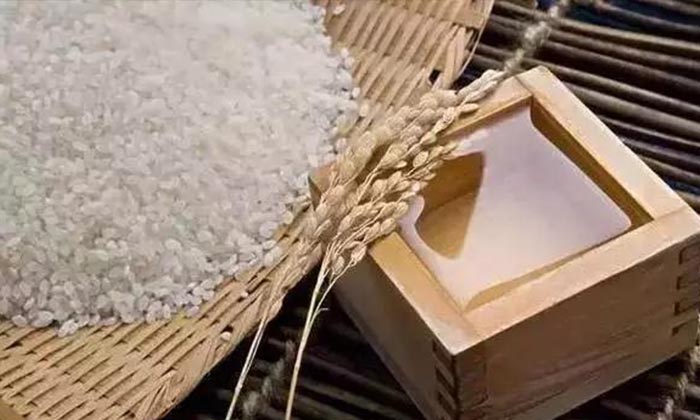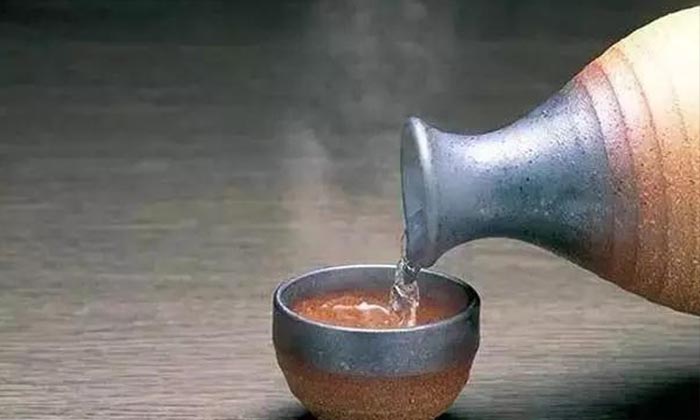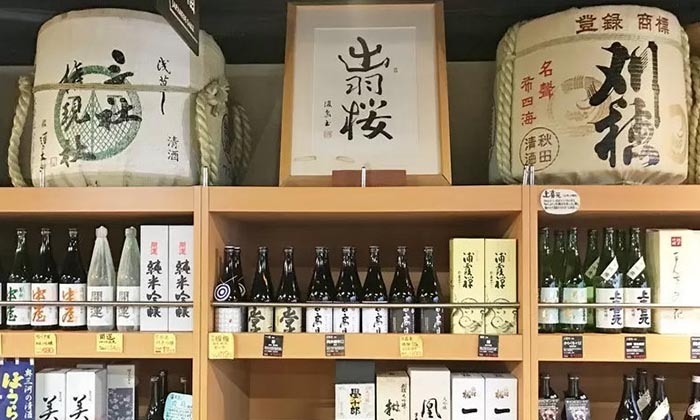Japanese Sake
Japanese Sake is made from rice harvested in the fall and fermented in the winter. In ancient times, there was only muddy wine in Japan and no sake. Later, some people added charcoal to the muddy wine to precipitate the muddy substance and took the clear part to drink. From then on, the name came to be Sake. Unlike brewed rice wine, the Japanese continue to refine the process, making exquisite and unparalleled sake.

Winemaking Ingredients: Water, rice, yeast
Water quality is divided into soft and hard; the difference between soft and hard is the number of minerals contained in the water. Soft water contains fewer minerals and the taste of the softened wine is sweeter and softer, light and refreshing. Hard water has a lot of minerals inside, and the wine is produced to taste strong and spicy, rich and mellow.
Japan is rich in rice, and the rice used for wine production is constantly being improved. Although the general consumption of rice can be used to make wine, when it comes to the charm and strength of the wine, the only thing that can be used is wine rice. Rice grains of sake rice is larger and softer than edible rice grains, and the core portion of the rice is relatively large and is rich in starch, showing an opaque milky white, which is the main element for brewing sake. Rice wine also has a low protein content, making it easy to mix flavors when brewing sake.
The raw materials of Japanese sake are only water and rice, so the yeast can determine the taste, aroma, and quality of the wine. Various yeasts have different characteristics, so to make a bottle of fine sake, you need good water, rice, and yeast. This is the esoteric knowledge of Japanese sake.

Sake brewing throughout Japan uses locally-produced rice and yeast and uses good water to produce sake with local characteristics. The main origins and characteristics of Japanese sake are divided into 10 regions, and the following are briefly introduced:
Hokkaido: The climate is very cold, so the process of brewing sake is slow. With excellent water quality and an environment suitable for brewing, Hokkaido's sake is matured after a long period of natural fermentation. Overall, the wine from Hokkaido is soft and refreshing.
Northeastern Japan: Akita is the leading Japanese sake producer in the Northeast, and includes other counties such as Aomori and Iwate. Many of the breweries in this area are the winners of the National New Wine Appraisal Conference. The northeast region has a cold climate and the wine can be naturally fermented and matured, and the taste is refreshing and round.
Kanto, Japan: The prefecture with the most breweries in the Kanto region is the Ibaraki Prefecture, which is also a famous Japanese sake producer. Sake that is produced mainly in Tokyo is clear.
Yamanashi Prefecture, Nagano, and Niigata Prefecture: Especially Niigata Prefecture, they are known as the Kingdom of Local Sake. Locally produced sake is fresh and spicy: Nagano uses unique Alpine yeast, and the sake has a strong aroma which looks much more rounded.
Kyushu: Kyushu includes Fukuoka, Saga, Kumamoto, Miyazaki, and other counties. Kumamoto is the birthplace of Kumamoto yeast, which is indispensable for brewing. A strong, sweet, smooth, and delicate wine with a sweet flavor is the mainstream of Kyushu's sake flavor, but only Kumamoto has more spicy wines.

With the different grades of sake, the temperature at the time of drinking is different. Generally speaking, pure rice wine, Honjo brewed wine, ordinary wine, strong taste, and high aroma wine are suitable for warm drinking. The slender aroma and taste of wine are more suitable for drinking after iced. There are about 2,000 breweries distributed throughout Japan, producing more than 10,000 kinds of wine. Among them, the most common Japanese sake brands in the country are Gekkeikan, Kikumasa, Ozeki, Hakutsuru, and so on. Regional brands include Sakuramasamune, Kamotsuru, Nihonsakari, Shirakabegura-mio, etc.
Japanese Sake Bar Recommendations:
Teno River (Keio Plaza Hotel)
For those will be tasting sake for the first time, Tenogawa in Keio Plaza Hotel is a good choice. Because it is located in the hotel, it attracts many foreign guests and is very convenient. The service staff here can give you a detailed introduction to each type of sake in English, which is very valuable to those who are not familiar with the sake grading system and flavor.
Address: Tokyo, Shinjuku City, Nishishinjuku, 2 Chome-2-1, Keio Plaza Hotel
Daimasu Kaminarimon
If you want to learn more about the sake culture, you must come to Daimasu Kaminarimon, which is located near the famous sightseeing spot "Asakusa Kaminarimon". The bar at the store always has more than 100 kinds of Japanese sake. The atmosphere here is like a real Izakaya; it is a base for Japanese people who come from work nearby. You can feel the Japanese drinking culture here very well if you decide to visit.
Address: 1 Chome-2-8 Asakusa, Taito City, Tokyo

Junmaishu Sake-Specialty YATA
In Sake House, YATA is a popular shop located in Nagoya, where they only collect pure rice sake. YATA also opened a branch in Tokyo due to the popular requests of fans. In addition to the main pure rice wine, the rule the store has is you can only be drinking, which also makes sake lovers want to experiment with various options.
Address: 3 Chome-14-22 Shinjuku, Shinjuku City, Tokyo
Ayaka Shuan-Suiko
Entering this small shop with only ten seats, it is the best choice to let the owner make the choices for you as they are very nice and full of personal charm. Whether it is food or wine, they all appear in front of you with their best manners, willing to give you the best experience.
Address: 1 Chome-51-6 Oshiage, Sumida City, Tokyo
As a reliable travel ageny in Japan, we offer the sake tours and sake experience in Japan for tourists from overseas. If you have any questions on Japanese sake, please free to contact us.
Japanese Sake is made from rice harvested in the fall and fermented in the winter. In ancient times, there was only muddy wine in Japan and no sake. Later, some people added charcoal to the muddy wine to precipitate the muddy substance and took the clear part to drink. From then on, the name came to be Sake. Unlike brewed rice wine, the Japanese continue to refine the process, making exquisite and unparalleled sake.
Japanese Saki and Rice Wine
The ingredients are simple, the method is complicated, and the taste is delicious. Sake is a traditional liquor fermented with rice, yeast, and water in Japan; it is also called Japanese sake in Japan. The average alcohol concentration is about 15%. Therefore, the factors that affect the flavor of Japanese sake are nothing more than water, rice, and the brewing yeast. In addition, the Japanese wine quality will show different flavors and geographical characteristics due to different origins.
Winemaking Ingredients: Water, rice, yeast
Water quality is divided into soft and hard; the difference between soft and hard is the number of minerals contained in the water. Soft water contains fewer minerals and the taste of the softened wine is sweeter and softer, light and refreshing. Hard water has a lot of minerals inside, and the wine is produced to taste strong and spicy, rich and mellow.
Japan is rich in rice, and the rice used for wine production is constantly being improved. Although the general consumption of rice can be used to make wine, when it comes to the charm and strength of the wine, the only thing that can be used is wine rice. Rice grains of sake rice is larger and softer than edible rice grains, and the core portion of the rice is relatively large and is rich in starch, showing an opaque milky white, which is the main element for brewing sake. Rice wine also has a low protein content, making it easy to mix flavors when brewing sake.
The raw materials of Japanese sake are only water and rice, so the yeast can determine the taste, aroma, and quality of the wine. Various yeasts have different characteristics, so to make a bottle of fine sake, you need good water, rice, and yeast. This is the esoteric knowledge of Japanese sake.

Sake brewing throughout Japan uses locally-produced rice and yeast and uses good water to produce sake with local characteristics. The main origins and characteristics of Japanese sake are divided into 10 regions, and the following are briefly introduced:
Hokkaido: The climate is very cold, so the process of brewing sake is slow. With excellent water quality and an environment suitable for brewing, Hokkaido's sake is matured after a long period of natural fermentation. Overall, the wine from Hokkaido is soft and refreshing.
Northeastern Japan: Akita is the leading Japanese sake producer in the Northeast, and includes other counties such as Aomori and Iwate. Many of the breweries in this area are the winners of the National New Wine Appraisal Conference. The northeast region has a cold climate and the wine can be naturally fermented and matured, and the taste is refreshing and round.
Kanto, Japan: The prefecture with the most breweries in the Kanto region is the Ibaraki Prefecture, which is also a famous Japanese sake producer. Sake that is produced mainly in Tokyo is clear.
Yamanashi Prefecture, Nagano, and Niigata Prefecture: Especially Niigata Prefecture, they are known as the Kingdom of Local Sake. Locally produced sake is fresh and spicy: Nagano uses unique Alpine yeast, and the sake has a strong aroma which looks much more rounded.
Kyushu: Kyushu includes Fukuoka, Saga, Kumamoto, Miyazaki, and other counties. Kumamoto is the birthplace of Kumamoto yeast, which is indispensable for brewing. A strong, sweet, smooth, and delicate wine with a sweet flavor is the mainstream of Kyushu's sake flavor, but only Kumamoto has more spicy wines.

With the different grades of sake, the temperature at the time of drinking is different. Generally speaking, pure rice wine, Honjo brewed wine, ordinary wine, strong taste, and high aroma wine are suitable for warm drinking. The slender aroma and taste of wine are more suitable for drinking after iced. There are about 2,000 breweries distributed throughout Japan, producing more than 10,000 kinds of wine. Among them, the most common Japanese sake brands in the country are Gekkeikan, Kikumasa, Ozeki, Hakutsuru, and so on. Regional brands include Sakuramasamune, Kamotsuru, Nihonsakari, Shirakabegura-mio, etc.
Japanese Sake Bar Recommendations:
Teno River (Keio Plaza Hotel)
For those will be tasting sake for the first time, Tenogawa in Keio Plaza Hotel is a good choice. Because it is located in the hotel, it attracts many foreign guests and is very convenient. The service staff here can give you a detailed introduction to each type of sake in English, which is very valuable to those who are not familiar with the sake grading system and flavor.
Address: Tokyo, Shinjuku City, Nishishinjuku, 2 Chome-2-1, Keio Plaza Hotel
Daimasu Kaminarimon
If you want to learn more about the sake culture, you must come to Daimasu Kaminarimon, which is located near the famous sightseeing spot "Asakusa Kaminarimon". The bar at the store always has more than 100 kinds of Japanese sake. The atmosphere here is like a real Izakaya; it is a base for Japanese people who come from work nearby. You can feel the Japanese drinking culture here very well if you decide to visit.
Address: 1 Chome-2-8 Asakusa, Taito City, Tokyo

Junmaishu Sake-Specialty YATA
In Sake House, YATA is a popular shop located in Nagoya, where they only collect pure rice sake. YATA also opened a branch in Tokyo due to the popular requests of fans. In addition to the main pure rice wine, the rule the store has is you can only be drinking, which also makes sake lovers want to experiment with various options.
Address: 3 Chome-14-22 Shinjuku, Shinjuku City, Tokyo
Ayaka Shuan-Suiko
Entering this small shop with only ten seats, it is the best choice to let the owner make the choices for you as they are very nice and full of personal charm. Whether it is food or wine, they all appear in front of you with their best manners, willing to give you the best experience.
Address: 1 Chome-51-6 Oshiage, Sumida City, Tokyo
As a reliable travel ageny in Japan, we offer the sake tours and sake experience in Japan for tourists from overseas. If you have any questions on Japanese sake, please free to contact us.
Related Articles You May Like
Most Frequently Asked Questions
-
What are the famous sake brands in Japan?There are about 2,000 breweries distributed throughout Japan producing more than 10,000 kinds of wine. Among them, the most common Japanese sake brands in the county are Gekkeikan, Kikumasu, Ozeki, Hakutsuru, and so on. regional brands include Sakuramasamune, Kamotsuru, Nihonsakari, Shirakabegura-mio, etc.
-
Where are the origins of Japanese sake?The main origins and characteristics of Japanese sake are divided into 10 regions, mainly including Hokkaido, Akita, Aomori, Iwate, in Northeastern Japan, Kanto, Japan's Ibaraki Prefecture, Yamanashi Prefecture, Nagano, and Niigata Prefecture, Fukuoka, Saga, Kumamoto, Miyazaki, etc.
-
What sake bars are there in Tokyo, Japan?Keio Plaza Hotel, YAT, Daimasu Kaminariomon, and Shuan-Suiko are all sake bars that are worth visiting. There are many kinds of sake and rich food mix, each having their own unique features. If you like it, you can also buy different sakes to bring back home.
-
Is there a bar inside Keio Plaza Hotel in Tokyo?There is a sake bar in the Keio Plaza hotel and because it is located in the hotel, it attracts many foreign guests. The service staff here can give you a detailed introduction to each type of sake in English, which is very valuable to those who are not familiar with the sake grading system and flavor. The address is Tokyo, Shinjuku City, Nishishinjuku, 2 Chome-2-1, Keio Plaza Hotel.
-
Is there a sake bar near Asakusa, Tokyo, Japan?Daimasu Kaminarimon is located near the famous sightseeing spot, Asakusa Kaminarimon. The bar at the restaurant always has more than 100 kinds of sake. The atmosphere here is like a real Izakaya; it is a base for Japanese people who come from work nearby. You can feel the Japanese drinking culture here very well if you decide to visit. The address is 1 Chome-2-8 Asakusa, Taito City, Tokyo.
-
Can I recommend a sake bar near Shinjuku, Tokyo, Japan?In Sake House, YATA is a popular shop located in Nagoya, where they only collect pure rice sake. YATA also opened a branch in Tokyo due to the popular requests of fans. In addition to the main pure rice wine, the rule the store has is you can only be drinking, which also makes sake lovers want to experiment with various options. The address is 3 Chome-14-22 Shinjuku, Shinjuku City, Tokyo.
-
Where is Shuan-Suiko's address in Tokyo, Japan?Tokyo Sake Bar Shuan-Suiko's address is 1 Chome-51-6 Oshiage, Sumida City, Tokyo. Entering this small shop with only ten seats, it is the best choice to give all the choices to the owner full of personal charm. Whether it is food or wine, they all appear in front of you in their best condition.
Japan Office
- Tel: +81 50-3701-6391
- Email: info@japanholiday.com
- Working Hours: 8am-7pm, (Japan)
USA Office
- Tel: +1-6265617117
- Email: info@japanholiday.com
- Working Hours: 8am-7pm, Pacific Time

